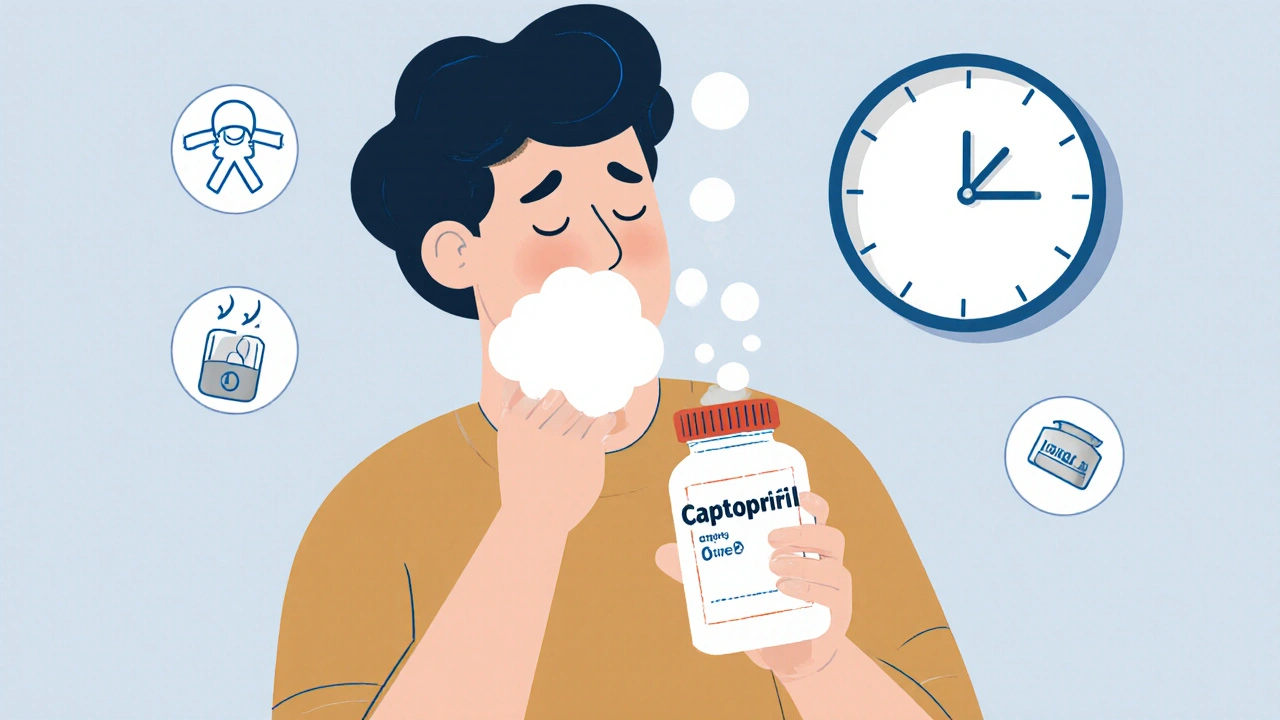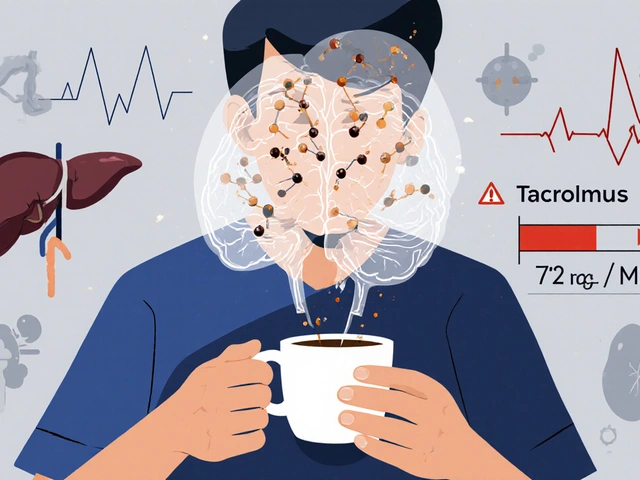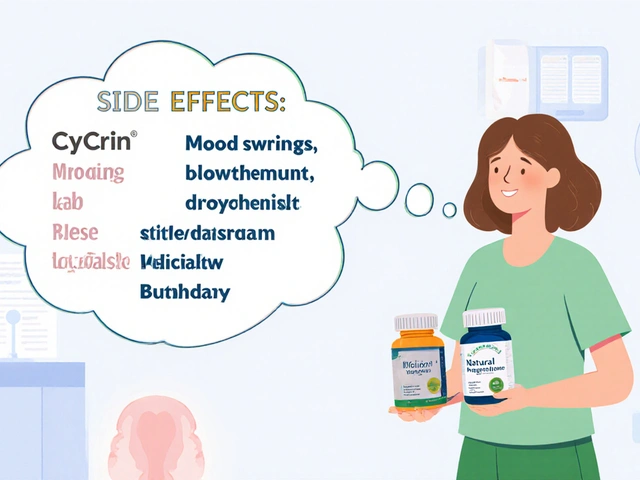Blood Pressure Medication Comparison Tool
Which Blood Pressure Medication Is Right for You?
This tool helps you compare Captopril alternatives based on your specific health conditions and preferences. Select your situation below to see which medications are most recommended for you.
If you’re taking Capoten (Captopril) for high blood pressure, you’ve probably wondered: are there better options? Maybe your doctor switched you, or you’re dealing with side effects like a dry cough, dizziness, or a strange metallic taste. You’re not alone. Many people on Captopril look for alternatives-not because they want to stop treatment, but because they want something that works just as well without the discomfort.
Captopril was one of the first ACE inhibitors approved in the U.S. back in 1981. It’s been around long enough to prove it lowers blood pressure and protects the heart and kidneys in people with diabetes. But today, newer drugs often get prescribed first. Why? Because they’re easier to tolerate, taken once a day, and have fewer side effects.
How Captopril Works
Captopril belongs to a class of drugs called ACE inhibitors. These block an enzyme called angiotensin-converting enzyme. When this enzyme is blocked, your body produces less angiotensin II-a chemical that tightens blood vessels. Less angiotensin II means your blood vessels relax, your blood pressure drops, and your heart doesn’t have to work as hard.
It’s fast-acting. Captopril starts working within 15 to 30 minutes after you take it. That’s why it’s sometimes used in emergencies, like during a hypertensive crisis. But its effects don’t last long-usually 4 to 6 hours. That’s why most people take it two or three times a day. That frequent dosing is one of the biggest reasons people switch.
Common Side Effects of Captopril
Not everyone has side effects, but enough do that it’s worth knowing what to watch for:
- Dry cough - The most common reason people stop taking it. It’s not an allergy-it’s how the drug affects bradykinin buildup in your airways.
- Dizziness or lightheadedness - Especially when standing up fast. Low blood pressure can cause this.
- Metallic or salty taste - Strange, but real. Some people describe it like tasting metal or saltwater.
- High potassium levels - Can be dangerous if you have kidney problems or take potassium supplements.
- Swelling (angioedema) - Rare but serious. If your face, lips, or tongue swell, seek help immediately.
These side effects are why many patients and doctors look for alternatives.
Top Alternatives to Captopril
There are several well-studied alternatives to Captopril. Most fall into two categories: other ACE inhibitors or ARBs (angiotensin receptor blockers). Both lower blood pressure the same way-but ARBs avoid the cough.
1. Lisinopril (Prinivil, Zestril)
Lisinopril is the most common replacement for Captopril. Like Captopril, it’s an ACE inhibitor-but it lasts longer. You take it once a day. No more midday doses.
It’s just as effective at lowering blood pressure and protecting the kidneys. Studies show it works equally well in people with diabetes and heart failure. The big win? It causes a dry cough in about 10% of users-slightly less than Captopril’s 15-20%. It’s also cheaper. Generic lisinopril costs under $5 a month at most pharmacies.
2. Enalapril (Vasotec)
Another once-daily ACE inhibitor. Enalapril is a prodrug, meaning your body converts it into its active form. That makes it slower to start working but longer-lasting. It’s often used in people with heart failure or after a heart attack.
Compared to Captopril, enalapril has fewer reports of taste disturbances. It’s also less likely to cause low blood pressure right after the first dose. If you’re switching from Captopril and had dizziness issues, enalapril might be smoother.
3. Losartan (Cozaar)
This is the most popular ARB. ARBs block angiotensin II at the receptor level instead of stopping its production. That means no buildup of bradykinin-and no dry cough.
Studies show losartan works just as well as lisinopril for lowering blood pressure. In fact, the LIFE trial found it reduced stroke risk better than atenolol in older patients with high blood pressure and left ventricular hypertrophy.
It’s also approved for people with diabetic kidney disease. If you have protein in your urine (a sign of kidney damage), losartan can slow that damage better than some other blood pressure drugs.
4. Valsartan (Diovan)
Valsartan is another ARB that’s often used when people can’t tolerate ACE inhibitors. It’s especially useful for people who’ve had a heart attack or have heart failure.
One study compared valsartan to captopril in patients after a heart attack. The results showed valsartan was just as effective at preventing death and hospital readmission-but with fewer side effects like cough and rash.
It’s also available in combination pills with a diuretic (like hydrochlorothiazide), which makes it easier to manage multiple medications.
5. Ramipril (Altace)
Ramipril is another ACE inhibitor, but it’s often chosen for people with high risk of heart attack or stroke-not just high blood pressure. The HOPE trial showed ramipril reduced heart attacks, strokes, and death by 22% in high-risk patients, even if their blood pressure wasn’t super high.
It’s taken once daily. Side effects are similar to lisinopril, but some people find ramipril gentler on the stomach. If you’re on Captopril because you have diabetes and kidney disease, ramipril might be a stronger choice.
Comparison Table: Captopril vs. Alternatives
| Drug | Class | Dosing Frequency | Onset of Action | Common Side Effects | Cost (Generic, monthly) |
|---|---|---|---|---|---|
| Captopril | ACE inhibitor | 2-3 times daily | 15-30 minutes | Dry cough, metallic taste, dizziness, high potassium | $10-$20 |
| Lisinopril | ACE inhibitor | Once daily | 1 hour | Dry cough (less than Captopril), dizziness | $4-$8 |
| Enalapril | ACE inhibitor | Once daily | 1-2 hours | Dry cough, fatigue, low blood pressure | $5-$10 |
| Losartan | ARB | Once daily | 1-2 hours | Dizziness, fatigue, high potassium (no cough) | $6-$12 |
| Valsartan | ARB | Once daily | 2 hours | Dizziness, back pain, high potassium (no cough) | $10-$20 |
| Ramipril | ACE inhibitor | Once daily | 1 hour | Dry cough, fatigue, low blood pressure | $8-$15 |
Which Alternative Is Right for You?
There’s no single best drug. The right choice depends on your health, symptoms, and goals.
- If you have a dry cough - Switch to an ARB like losartan or valsartan. You’ll likely feel better within days.
- If you need the cheapest option - Lisinopril is the most affordable and just as effective.
- If you have heart failure or had a heart attack - Ramipril or enalapril have stronger evidence for reducing death risk.
- If you have diabetic kidney disease - Losartan or ramipril are preferred because they protect kidney function better than other options.
- If you’re on multiple medications - Look for combination pills like valsartan/hydrochlorothiazide. Fewer pills = better adherence.
Don’t switch on your own. Talk to your doctor. Stopping Captopril suddenly can cause your blood pressure to spike. Your doctor will likely taper you off slowly and start the new drug at a low dose.
What About Natural Alternatives?
Some people look to diet, supplements, or lifestyle changes to replace medication. While these help, they don’t replace drugs like Captopril for moderate to severe high blood pressure.
Here’s what actually works:
- Reducing salt - Cutting sodium to under 1,500 mg/day can lower systolic pressure by 5-10 mmHg.
- Exercise - 30 minutes of walking 5 days a week can drop blood pressure by 5-8 mmHg.
- Weight loss - Losing 10 pounds can lower pressure by about 5 mmHg.
- Potassium-rich foods - Bananas, spinach, sweet potatoes help balance sodium-but avoid potassium supplements if you’re on ACE inhibitors or ARBs.
These changes support your medication. They don’t replace it. If your blood pressure is 160/100 or higher, you need a drug-not just celery juice or garlic pills.
What to Expect When Switching
If your doctor switches you from Captopril to lisinopril or losartan:
- You’ll probably start the new drug at a low dose.
- You might feel a little lightheaded for the first few days.
- Your dry cough should fade within 1-2 weeks if it’s from Captopril.
- Your doctor will check your potassium and kidney function in 1-2 weeks.
Most people feel better within a week. Some notice improved sleep, less dizziness, or more energy.
When Not to Switch
Some people do great on Captopril. If you’ve been on it for years without side effects, and your blood pressure is under control, there’s no need to change.
Also, if you’ve had a successful pregnancy while on Captopril (rare, but possible), your doctor might keep you on it. Other ACE inhibitors and ARBs are not safe during pregnancy. Captopril is sometimes used under strict supervision.
Don’t switch just because a friend says their drug is better. What works for one person might not work for you.
Is Captopril still used today?
Yes, but less often. It’s still prescribed for hypertensive emergencies, people who can’t afford newer drugs, or those who respond well to it without side effects. Most new prescriptions go to once-daily drugs like lisinopril or losartan.
Can I switch from Captopril to losartan on my own?
No. Stopping Captopril suddenly can cause your blood pressure to rise sharply. Always work with your doctor. They’ll guide you through a safe transition, often overlapping the drugs for a few days before fully switching.
Which is better for kidney protection: Captopril or losartan?
Both protect the kidneys in people with diabetes. Studies show losartan and ramipril are slightly better at reducing protein in urine over time. But Captopril still works well. The key is consistent use, not the specific drug.
Does Captopril cause weight gain?
No. Captopril doesn’t cause weight gain. Some people gain weight because they feel better and eat more. Others lose weight due to nausea or loss of appetite. Weight changes are usually unrelated to the drug itself.
Are there any foods I should avoid while taking Captopril?
Avoid salt substitutes that contain potassium, like NoSalt or Nu-Salt. Also limit potassium-rich foods if you’re on high doses or have kidney disease. Don’t take potassium supplements unless your doctor says so. Too much potassium can cause dangerous heart rhythms.
Final Thoughts
Captopril saved lives when it first came out. Today, it’s a reliable option-but not always the most convenient. If you’re struggling with side effects, there are better choices. Lisinopril, losartan, and ramipril offer similar benefits with fewer daily doses and less discomfort.
The goal isn’t to find the "best" drug. It’s to find the one you can take every day without feeling awful. Talk to your doctor. Ask about alternatives. And don’t give up on treatment-high blood pressure is silent, but it’s not unstoppable.










